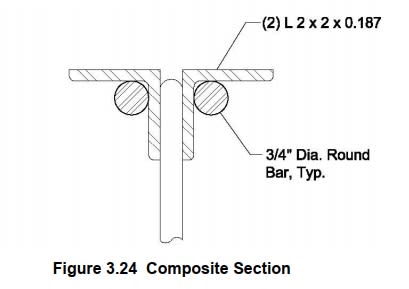Hey guys,
I'm evaluating the capacity of an existing OWSJ and am determining whether or not reinforcement will be required. Client wants to give occupant access to the roof area (additional 4.8 kPa loading). I'm using Skyciv to determine the factored loads in each member. A coworker has me referencing Example 3.1 in "Technical Digest 12 - Evaluation and modification of open-web steel joists and joist girders" which I have attached. I don't believe this example is checking the proper limit state. Hoping to get the opinion of others on the matter. Here's a bit more information:
-Top chord for my case and in the case of example 3.1 are back to back angles.
-example 3.1 determines the composite section properties of the two back to back angles along with the proposed reinforcing. These section properties are used to check for buckling of the top chord assuming an effective length equal to the panel width.

Here's my question:
The back to back angles are not continuously connected along their length (atleast the examples has no mention of this). Should we not be calculating section properties of a single angle with reinforcement and checking buckling using the minimum radius of gyration?
Thanks in advance!
I'm evaluating the capacity of an existing OWSJ and am determining whether or not reinforcement will be required. Client wants to give occupant access to the roof area (additional 4.8 kPa loading). I'm using Skyciv to determine the factored loads in each member. A coworker has me referencing Example 3.1 in "Technical Digest 12 - Evaluation and modification of open-web steel joists and joist girders" which I have attached. I don't believe this example is checking the proper limit state. Hoping to get the opinion of others on the matter. Here's a bit more information:
-Top chord for my case and in the case of example 3.1 are back to back angles.
-example 3.1 determines the composite section properties of the two back to back angles along with the proposed reinforcing. These section properties are used to check for buckling of the top chord assuming an effective length equal to the panel width.

Here's my question:
The back to back angles are not continuously connected along their length (atleast the examples has no mention of this). Should we not be calculating section properties of a single angle with reinforcement and checking buckling using the minimum radius of gyration?
Thanks in advance!
